Nordic countries
The Nordic countries make up a region in Northern Europe called the Nordic region, consisting of Denmark, Finland, Iceland, Norway and Sweden and their associated territories which include the Faroe Islands, Greenland and Åland. Scandinavia is sometimes used as a synonym for the Nordic countries,[1] although within the Nordic countries the terms are considered distinct.
The region's five nation-states and three autonomous regions share much common history as well as common traits in their respective societies, such as political systems and the Nordic model. Politically, Nordic countries do not form a separate entity, but they co-operate in the Nordic Council. Linguistically, the area is heterogeneous, with three unrelated language groups, the North Germanic branch of Indo-European languages and the Baltic-Finnic and Sami branches of Uralic languages as well as the Eskimo-Aleut language Kalaallisut spoken in Greenland. The Nordic countries have a combined population of approximately 25 million spread over a land area of 3.5 million km² (Greenland accounts for 60% of the total area).
Recently, Estonia has also projected itself as a Nordic country, although it is widely considered to be a Baltic state. Estonia has close linguistic, ethnic and cultural ties with Finland, was part of the Danish and Swedish empires for many centuries, has cultural ties with Sweden and Denmark, and most of its investment and trade is with the Nordic countries.
Contents |
Etymology and terminology
The term 'Nordic Countries' is derived from the French term Pays Nordiques as an equivalent of the local terms Norden (Scandinavian languages), Pohjola / Pohjoismaat (Finnish language), Põhjamaad (Estonian language), Norðurlönd (Icelandic), Norðurlond (Faroese) and Davveriikkat (North Sámi) with the meaning of "The North(ern lands)".
In English usage, the term Scandinavia is sometimes used — though not consistently — as a synonym for the Nordic countries. From the 1850s, Scandinavia came to include, politically and culturally, Denmark, Norway, Sweden and Finland. Geographically, the Scandinavian Peninsula includes mainland Sweden and mainland Norway, and also a part of Finland, while the Jutland Peninsula includes mainland Denmark and a small part of Germany. Denmark proper has not included any territory on the Scandinavian Peninsula since 1658. The Faroe Islands and Iceland are "Scandinavian" in the sense that they were settled by Scandinavians and speak Scandinavian languages, but geographically they are not part of Scandinavia. Having once been a part of Sweden, Finland has been significantly influenced by Swedish culture and part of it is geographically within Scandinavia, whereas the Finnish language is not related to the Scandinavian languages. Greenland was settled by the Norse, and is currently part of the Danish realm, with the Danish language spoken by nearly all inhabitants, while geographically it is part of North America.
In geology, the term for the land area which lies above sea level on the Baltic shield (also known as the Fennoscandian Shield) is Fennoscandia (from the Latin toponyms Fennia and Scania).
Merriam-Webster Online Dictionary defines "Nordic" as an adjective dated to 1898 with the meaning "of or relating to the Germanic peoples of northern Europe and especially of Scandinavia" or "of or relating to a group or physical type of the Caucasian race characterized by tall stature, long head, light skin and hair, and blue eyes". [2] In the light of linguistic-based race theories, Germany would be a Nordic country instead of Finland whose population generally features the previously mentioned stereotypical phenotype and a Uralic majority language. Before the 19th century and romantic nationalism, the term Nordic may have been used more as a synonym for Northern to mean Northern Europe including the Baltic countries (at that time Lithuania, Livonia and Courland) and occasionally the British Isles and other lands on the shores of the Baltic and North Seas.
History
- See also: History of Scandinavia
The Nordic countries are characterised by similar structures of their societies and cultural traits. This results not only from similar environmental realities and thus traditional livelihoods but also from a shared history.
During the Dark Ages, what are now Norway, Sweden, Denmark and from 10th century onwards also Iceland shared a similar cultural, linguistic (Old Norse) and religious (Norse mythology) environment. From ca. the 12th century onwards what is now Finland (linguistically Baltic-Finnic and broader Finno-Ugric) started sharing the common developments as it was increasingly integrated into the kingdom of Sweden. As another example of a deeply rooted unifying past could be taken the indigenous Sami lifestyle (linguistically Finno-Ugric) across what is now northern Norway, Sweden and Finland (and beyond). Indeed, all Nordic countries have minority groups deriving or claiming heritage of a population residing within another Nordic state.
After being Christianized around the year 1000, the process of local unification established Denmark, Norway and Sweden as separate kingdoms. Finland became part of Sweden in the mid 1200s, whereas Iceland, the Faroe Islands, the Shetland Islands, Orkney, Greenland and large parts of Scotland and Ireland belonged to Norway. All Nordic countries followed the Protestant Reformation of the Western church during the 16th century and adopted Lutheran state churches - still having a large membership count, although state church status varies. Finland also has a much smaller Orthodox state church whose members, 1.1% of population, mainly come from the areas that were outside the Swedish realm when Christianity was introduced.
In the 14th century, Denmark, Norway (with Iceland) and Sweden (with Finland) were united under one regent, in the Kalmar Union. Denmark quickly gained the upper hand, but in the early 16th century Sweden reestablished itself as a separate kingdom. Denmark's domination over Norway lasted until 1814 when the king was forced to cede Norway to the king of Sweden. Iceland, Greenland and the Faroe Islands remained Danish.
After establishing itself as one of the Great powers in Europe during the 17th century Sweden ultimately lost its foreign Dominions one by one. This process culminated in the loss of Finland to Russia in 1809 which became an autonomous Grand Duchy under the Russian tsar.
The 19th century saw a personal union between Sweden and Norway which was dissolved in 1905 due to growing dissatisfaction from the Norwegian part. From 1840s Scandinavism emerged in Scandinavia. This movement strove to unite the three Scandinavian kingdoms into one, diminishing after Sweden refused to help Denmark on war in 1864.
In the midst of the Russian revolutions, Finland emerged for the first time as an independent nation, orienting for a Nordic community. During World War II in 1944, Iceland gained its independence from Denmark. The member states of the Nordic council (founded in 1952) had thus emerged.
The Nordic countries share similar traits in the policies implemented under the postwar period, especially in the socioeconomic area. All Nordic countries have large tax-funded public welfare sectors and extensive socialist legislation. In most cases, this is due to the political ambitions of the many Social Democrat governments that came to power during the interwar period in each of the Nordic countries.
Chronology of the Nordic countries
| Century | Nordic Political Entities | |||||
| 21st | Denmark (EU) | Faroes (Denmark) | Iceland | Norway | Sweden (EU) | Finland (EU) |
| 20th | Denmark | Sweden | Finland | |||
| 19th | Denmark | Sweden and Norway (personal union) |
Russia (GD of Finland) |
|||
| 18th | Denmark-Norway (personal union) | Sweden (or Sweden-Finland) |
||||
| 17th | ||||||
| 16th | ||||||
| 15th | Kalmar Union | |||||
| 14th | Denmark | Norway | Sweden | |||
| 13th | ||||||
| 12th | Faroes | Icelandic CW | Norway | |||
| Nordic Peoples | Danes | Faroese | Icelanders | Norwegians | Swedes | Finns |
Nordic Passport Union
The Nordic Passport Union, created in 1954, and implemented on May 1, 1958, allows citizens of the Nordic countries: Denmark (Faroe Islands included since January 1, 1966, Greenland not included), Sweden, Norway (Svalbard, Jan Mayen, Bouvet Island and Queen Maud's Land not included), Finland and Iceland (since September 24, 1965) to cross approved border districts without carrying and having their passport checked. Other citizens can also travel between the Nordic countries' borders without having their passport checked, but still have to carry some sort of approved travel identification documents.
Since 1996, these countries have joined the larger EU directive Schengen Agreement area, comprising 30 countries in Europe. Border checkpoints have been removed within the Schengen zone and only a national ID card is required. Within the Nordic area any ID card, e.g. driving licence is valid for Nordic citizens, because of the Nordic Passport Union.
From March 25 2001, the Schengen acquis fully applied to the five countries of the Nordic Passport Union (except for the Faroe Islands). There are some areas in the Nordic Passport Union that give extra rights for Nordic citizens, not covered by Schengen, such as less paperwork if moving to a different Nordic country, and fewer requirements for naturalisation.
Political dimension and divisions
| EU | Eurozone | NATO | |
|---|---|---|---|
| Denmark | x | x | |
| Finland | x | x | |
| Iceland | x | ||
| Norway | x | ||
| Sweden | x |
The Nordic region has a political dimension in the joint official bodies called the Nordic Council and the Nordic Council of Ministers. In this context, several aspects of the common market as in the European Union have been implemented decades before the EU implemented them. Intra-Nordic trade is not covered by the CISG, but by local law.
In the European Union, the Northern Dimension refers to external and cross-border policies covering the Nordic countries, the Baltic countries, and Russia.
The political cooperation between the Nordic Countries has not led to a common policy or an agreement on the countries' memberships in the European Union, Eurozone, and NATO. Norway and Iceland are only members of NATO, while Finland and Sweden are only members of the European Union. Denmark alone participates in both organizations. Only Finland is a member of the Eurozone. The tasks and policies of the European Union overlap with the Nordic council significantly, e.g. the Schengen Agreement partially supersedes the Nordic passport free zone and a common labor market.
Flags and symbols
Flags
All Nordic countries, including the autonomous territories of Faroe and Åland Islands, have a similar flag design, all based on the Dannebrog, the Danish flag. They display an off-center cross with the intersection closer to the hoist, the "Nordic cross".
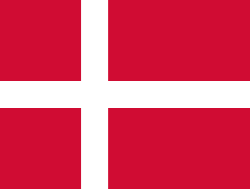 |
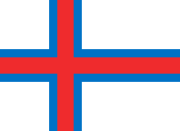 |
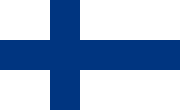 |
 |
 |
 |
 |
| Denmark | Faroe Islands | Finland | Iceland | Norway | Sweden | Åland |

Greenland and the Sami people have adopted flags without the Nordic cross, but they both feature a circle which is placed off-center like the cross.
 |
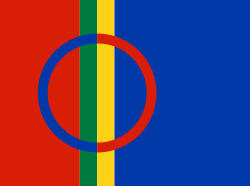 |
| Greenland | The Sami people |
Population
Population of the Nordic countries:
1. Sweden - 9,223,766
2. Denmark - 5,475,791
3. Finland - 5,329,585 (including Åland with a population of 27,210)
4. Norway - 4,752,735
5. Iceland - 319,355
6. Greenland - 56,344
7. Faroe Islands - 48,317
Consequently, the combined population numbers of the Nordic countries amount to a sum total of 25,205,893.
Areas with close relations to the Nordic countries
Several areas have a long and close relationship with and often identify with some or all of the Nordic countries. These are however for the most part not regarded as part of the Nordic group themselves, although classified as Northern Europe by the United Nations.
Shetland and Orkney
The Northern Isles of Scotland - Orkney and Shetland - have a long-established Nordic identity. The islands were Norwegian colonies for more than 500 years, but ownership defaulted to the crown of Scotland in 1472 following non-payment of the marriage dowry of Margaret of Denmark and Norway, queen of James III of Scotland.
During World War II Shetland and Orkney were important bases for the Norwegian armed forces in exile. The Shetland Bus was based in Shetland and smuggled refugees, agents and supplies to and from Norway.
In later years financial relations, particularly in the maritime industries, have been important. Cultural and sporting exchanges are frequent. A genetic survey showed that 60% of the male population of Shetland and Orkney had Norwegian genes.
The traditional links to Scandinavia are reflected in the islands' flags, both of which are based around a Nordic cross:
 |
 |
| Orkney | Shetland |
Other regions of the British Isles have adopted symbols to allude to a similar Norse or Norse-Gaelic heritage.
Estonia
Estonians consider themselves a Nordic people rather than Balts,[3][4] based on strong linguistic, cultural and historical ties with Finland in particular, and also with Sweden and Denmark. The Estonian language is closely related to the Finnish language, and Estonians, as an ethnic group, are a Finnic people. Estonia was part of the Danish and Swedish empires for many centuries prior to its absorption into the Russian Empire. It is generally thought that the name of the Estonian capital, Tallinn, derives from the Estonian taani linn, meaning 'Danish town'.
 |
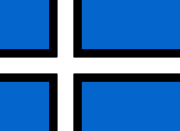 |
 |
| Flag of Estonia | Proposed Estonian flag featuring a Nordic cross |
Flag proposed in 1919 |
Historically, large parts of Estonia’s north-western coast and islands have been populated by an indigenous ethnically Swedish population (Estonian Swedes). The majority of Estonia's Swedish population fled to Sweden in 1944, escaping the advancing Soviet Army. In 2007, Estonian Swedes were granted official cultural autonomy under Estonian law.[5]
Since regaining independence in 1991, Estonia has expressed interest in identifying with the Nordic community. In 1999, Estonian Foreign Minister — and current president since 2006 — Toomas Hendrik Ilves delivered a speech entitled "Estonia as a Nordic Country" to the Swedish Institute for International Affairs.[6] In 2003, the foreign ministry also hosted an exhibit called "Estonia: Nordic with a Twist."[7] In 2005, Estonia also joined the European Union's Nordic Battle Group and shows interest in joining the Nordic Council.
Today there is a great deal of economic interdependence between Estonia and some of its Nordic neighbors. Three quarters of investments into Estonia come from Nordic states (principally Finland and Sweden), to which Estonia sends 58% of its exports. On the other hand, the Estonian political system and non-welfare-state model distinguish it from the Nordic states, and from many other European countries.
England
Anglo-Saxon England was founded in part by Jutes in Kent, the Isle of Wight and the national saga of England is Beowulf, carried to England by the Wuffings of East Anglia. Much of England, particularly East Anglia, Mercia and Northumbria were once part of the Danelaw. The story of Lady Godiva and Peeping Tom, London Bridge Is Falling Down and Sigurd the Dane of Macbeth fame come from this period of an Anglo-Scandinavian "Empire of the North". After England's population stabilised into a nation-state, Sweyn Forkbeard's family, which went back to Denmark from the Danish colonies in the West (see Harthacnut of Denmark), took over Wessex partly with the excuse of St. Brice's Day massacre and stratified as well as unified the government of England into four regional jarldoms under control by Danes and Norwegians as well as promoting the church of England in Scandinavia at the expense of the German church. This led to the later installment of the Archdiocese of Nidaros, which administered the Diocese of Sodor and Man formerly belonging to the Province of York (and would later reconnect upon Norse land cessions) by the English Pope Adrian IV. Direct relations between Denmark and England would continue intermittently until the reign of Eystein II of Norway, but the take overs of both by Eric of Pomerania and William of Normandy respectively, divided their focuses to re-attachment with Continental Europe instead. There was a much later interjection of New Sweden amidst the New England and Virginia colonies, but the relationship was much different in that period.
Hedeby
Finally, the northernmost part of Germany, Southern Schleswig on the Jutland peninsula, had a Scandinavian identity in Hedeby and Angeln up until its transfer to Germany in the mid 19th century and its subsequent Germanisation. Today, the Nordic character of Southern Schleswig's society and its inhabitants is still very prominent.
See also
- Scandinavia
- Subdivisions of the Nordic countries
- Nordic Council
- Nordic Cross
- Northern Dimension
- Thule
- West Nordic Council
- Baltic countries
- Baltic region
- Largest Nordic Companies
- Northern Europe
- Climate of the Nordic countries
- Nordic countries a journal created by Institut Choiseul for International Politics and Geoeconomics
References
- ↑ "Scandinavia" (although sometimes the term is used excluding some of these areas, often Finland). In Merriam-Webster's Online Dictionary. Retrieved 10 January 2008: "Scandinavia: Denmark, Norway, Sweden — sometimes also considered to include Iceland, the Faeroe Islands, & Finland." (Merriam-Webster Online Dictionary defines "Nordic" as an adjective dated to 1898 with the meaning "of or relating to the Germanic peoples of northern Europe and especially of Scandinavia."), "Scandinavia" (2005). The New Oxford American Dictionary, Second Edition. Ed. Erin McKean. Oxford University Press, ISBN 0-19-517077-6: "a cultural region consisting of the countries of Norway, Sweden, and Denmark and sometimes also of Iceland, Finland, and the Faroe Islands"; Scandinavia (2001). The Columbia Encyclopedia, Sixth Edition. Retrieved January 31, 2007: "Scandinavia, region of N Europe. It consists of the kingdoms of Sweden, Norway, and Denmark; Finland and Iceland are usually considered part of Scandinavia"; Scandinavia. (2007). Encyclopædia Britannica. Retrieved January 31, 2007, from Encyclopædia Britannica Online: "Scandinavia, historically Scandia, part of northern Europe, generally held to consist of the two countries of the Scandinavian Peninsula, Norway and Sweden, with the addition of Denmark"; and Scandinavia. (2006). Microsoft Encarta Online Encyclopedia. Retrieved January 30, 2007: "Scandinavia (ancient Scandia), name applied collectively to three countries of northern Europe—Norway and Sweden (which together form the Scandinavian Peninsula), and Denmark".
- ↑ Nordic. Merriam-Webster Online Dictionary. Retrieved 3 March 2008.
- ↑ "Estonian Life". Estonian Ministry of Foreign Affairs publication, 2004.
- ↑ "Estonian Life". Estonian Ministry of Foreign Affairs publication, 2002.
- ↑ "Estonian Swedes Embrace Autonomy Rights" Citypaper, 2007
- ↑ Ilves, Toomas Hendrik. "Estonia as a Nordic Country". December 14, 1999.
- ↑ "Estonia - Nordic with a Twist". Estonian Ministry of Social Affairs, 2004 (last updated).
External links
- Norden — the Nordic Council and the Nordic Council of Ministers' website.
- Nordregio — a European centre for research, education and documentation on spatial development, established by the Nordic Council of Ministers.
- NordRegio Statistics — a collection of thematic maps and figures of Nordic and Baltic countries by NordRegio.
- Go Scandinavia — official website of the Scandinavian Tourist Boards in North America.
- Scandinavia House — the Nordic Center in New York, run by the American-Scandinavian Foundation.
|
||||||||
